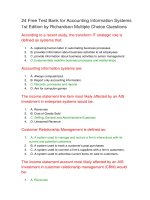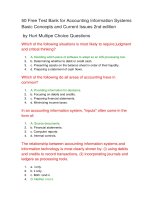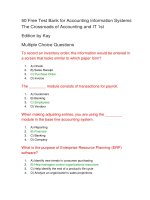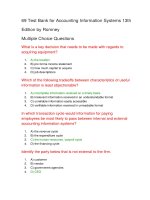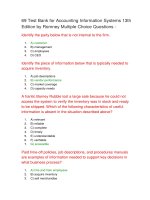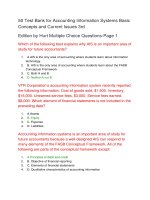Test bank for accounting information systems basic concepts and current issues 2nd edition hurt
Bạn đang xem bản rút gọn của tài liệu. Xem và tải ngay bản đầy đủ của tài liệu tại đây (391.47 KB, 21 trang )
Full file at />
Multiple Choice Questions
1. Which of the following are parts of most accounting information systems?
a.
b.
c.
D.
Activities and documents only.
Activities and technology only.
Documents and technology only.
Activities, documents and technology.
Answer: D Difficulty: Easy Learning objective: 1
2. Accounting information systems are designed to:
a.
b.
C.
d.
Minimize cost.
Maximize use of information technology.
Report information to decision makers.
Eliminate the need for paper documents.
Answer: C Difficulty: Easy Learning objective: 1
3. Which of the following statements about accounting information systems is most true?
A.
b.
c.
d.
They transform data into information.
They transform information into data.
They transform data into decisions.
They transform information into decisions.
Answer: A
Difficulty: Easy Learning objective: 1
4. Accounting information systems:
a.
b.
C.
d.
Emphasize that the areas of accounting (financial, tax and so on) are
separate and unrelated.
Focus on problems that have deterministic answers.
Is an important foundation for the study of auditing.
Is the most important area of accounting study.
Answer: C Difficulty: Easy Learning objective: 2
buy this full document at
Full file at />5. AIS study focuses on:
A.
b.
c.
d.
Developing critical thinking and judgment skills.
Finding the "one right answer" to a problem.
Identifying deterministic solutions that can be applied universally.
Computers and other forms of information technology.
Answer: A
Difficulty: Easy Learning objective: 2
6. The study of accounting information systems incorporates knowledge from:
a.
b.
c.
D.
Management and finance only.
Management and information systems only.
Finance and information systems only.
Management, finance and information systems.
Answer: D Difficulty: Easy Learning objective: 2
7. Consider the following two statements about accounting information systems: (i) AIS
incorporates more problems with deterministic solutions than other areas of accounting.
(ii) AIS is more integrative than other areas of accounting. Which of the statements is/are
true?
a.
B.
c.
d.
i only.
ii only.
Both i and ii.
Neither i nor ii.
Answer: B Difficulty: Easy Learning objective: 3
8. Which of the following links the study of accounting information systems with the
study of intermediate accounting?
A.
b.
c.
d.
Discussion of the FASB Conceptual Framework.
An emphasis on finding one right answer to every problem.
No need for judgment or decision making.
Memorizing the standards for preparing financial statements.
Answer: A
Difficulty: Easy Learning objective: 3
9. _____ in an accounting information system helps promote _____ in the financial
statements.
a. Documents, accuracy.
B. Internal controls, reliability.
c. Information technology, matching.
buy this full document at
Full file at />d. Data, relevance.
Answer: B Difficulty: Easy Learning objective: 3
10. A typical accounting information system comprises ___ parts.
a.
b.
C.
d.
Three.
Four.
Five.
Six.
Answer: C Difficulty: Easy Learning objective: 4
11. Accounting information systems typically incorporate which of the following: (i) inputs,
(ii) outputs, (iii) storage.
a. i and ii only.
b. ii and iii only.
c. i and iii only.
D. i, ii, and iii.
Answer: D Difficulty: Easy Learning objective: 4
12. In an accounting information system, "inputs" often come in the form of:
A.
b.
c.
d.
Source documents.
Financial statements.
Computer reports.
Internal controls.
Answer: A
Difficulty: Easy Learning objective: 4
13. According to the text, information about accounting information systems on the Internet
falls into ___ main groups.
a. Two.
B. Three.
c. Four.
d. Five.
Answer: B Difficulty: Easy Learning objective: 5
14. What type of information involves paying a fee to have it published on the Internet?
A. Sponsored/commercial.
buy this full document at
Full file at />b. Practitioner.
c. Scholarly.
d. Relevant.
Answer: A
Difficulty: Easy Learning objective: 5
15. Evaluating information reliability is part of:
a.
b.
C.
d.
Information relevance.
Information overload.
Information literacy.
Information transformation.
Answer: C Difficulty: Easy Learning objective: 5
16. Accounting information systems incorporate interrelated activities such as:
a.
b.
C.
d.
Debiting and crediting accounts.
Developing and solving problems with one right answer.
Buying and selling inventory.
Suggesting new elements and new levels for the conceptual framework.
Answer: C Difficulty: Medium Learning objective: 1
17. Documents in an accounting information system are:
a. Always paper-based.
b. Always electronic.
C. Either paper-based or electronic.
d. Neither paper-based nor electronic.
Answer: C Difficulty: Medium Learning objective: 1
18. Accounting information systems involve choices such as: (i) whether or not to
incorporate information technology, (ii) whether or not to pre-number documents like
checks.
A.
b.
c.
d.
i only.
ii only.
Both i and ii.
Neither i nor ii.
Answer: A
Difficulty: Medium Learning objective: 1
buy this full document at
Full file at />19. Which of the following best demonstrates the relationship between accounting
information systems and other areas of accounting?
a. Tax accountants have to create budgets.
b. Auditors often prepare tax returns for their clients.
C. Virtually all areas of accounting involve inputs, processes, outputs, storage and
internal controls.
d. Accounting information systems is the most important area of accounting.
Answer: C Difficulty: Medium Learning objective: 2
20. Which of the following situations is most likely to require judgment and critical
thinking?
A. Deciding which piece of software to adopt as an AIS processing tool.
b. Determining whether to debit or credit cash.
c. Presenting assets on the balance sheet in order of their liquidity.
d. Preparing a statement of cash flows.
Answer: A
Difficulty: Medium Learning objective: 2
21. The relationship between accounting information systems and information technology is
most clearly shown by: (i) using debits and credits to record transactions, (ii) incorporating
journals and ledgers as processing tools.
a. i only.
b. ii only.
c. Both i and ii.
D. Neither i nor ii.
Answer: D Difficulty: Medium Learning objective: 2
22. Problems in accounting information systems are often less likely to have deterministic
answers than problems in other areas of accounting. Which of the following questions has a
deterministic answer?
a. Should AIS documents be paper or electronic?
B. What is the balance in cash as of August 19, 2006?
c. What are the costs and benefits of using information technology in the AIS?
d. At what point does an amount become "material" as the term is defined in the conceptual
framework?
Answer: B Difficulty: Medium Learning objective: 3
buy this full document at
Full file at />23. Which of the following do all areas of accounting have in common?
A. Providing information for decisions.
b. Focusing on debits and credits.
c. Preparing financial statements.
d. Minimizing income taxes.
Answer: A
Difficulty: Medium Learning objective: 3
24. Both accounting information systems and intermediate accounting can incorporate the
conceptual framework of accounting as a topic. Which part of the conceptual framework
most closely corresponds with the "outputs" of an accounting information system?
a.
b.
c.
D.
Assumptions.
Principles.
Constraints.
Elements of financial statements.
Answer: D Difficulty: Medium Learning objective: 3
25. Which of the following is NOT an example of an input to the accounting information
system?
a.
b.
c.
D.
Sales invoice.
Purchase order.
Customer check.
Balance sheet.
Answer: D Difficulty: Medium Learning objective: 4
26. Outputs from an accounting information system include: (i) income statements, (ii) tax
returns, (iii) decisions.
A. i and ii only.
b. ii and iii only.
c. i and iii only.
d. i, ii and iii.
Answer: A
Difficulty: Medium Learning objective: 4
27. Internal controls in an accounting information system help promote information
integrity. Which of the following best explains the concept of information integrity?
buy this full document at
Full file at />a. Financial statements are subject to audit.
b. Users can rely on the financial statements as the sole basis for decisions.
C. The information in AIS outputs is reliable.
d. Accounting information systems that incorporate computer software are more reliable than
paper-based systems.
Answer: C Difficulty: Medium Learning objective: 4
28. As the term is used in information literacy, "currency" means:
a.
b.
C.
d.
Information over one year old should not be used for decisions.
Financial information is more important than non-financial information.
Decision makers should pay attention to publication dates.
Financial statements should be converted to US dollars whenever possible.
Answer: C Difficulty: Medium Learning objective: 5
29. An author's identity and background are most closely related to which element of
information competence?
A. Authority.
b. Accuracy.
c. Objectivity.
d. Coverage.
Answer: A
Difficulty: Medium Learning objective: 5
30. Recently, Bumble Beasley was researching information published in 1985. Which of the
following topics would he most likely consider "non-current" in his research?
a. Elements of financial statements.
b. Basic parts of an accounting information system.
C. Computer security techniques.
d. Purpose of accounting.
Answer: C Difficulty: Medium Learning objective: 5
31. Which of the following is the best example of "information" as the term is used in
"accounting information systems?"
a. Rules of debit and credit.
B. Budgets.
c. Conceptual framework of accounting.
d. Source documents.
buy this full document at
Full file at />Answer: B Difficulty: Medium Learning objective: 1
32. The "information" in an accounting information system should be: (i) timely, (ii) truthful,
(iii) reliable.
a. i and ii only.
b. ii and iii only.
C. i and iii only.
d. i, ii and iii.
Answer: C Difficulty: Medium Learning objective: 1
33. A well-designed accounting information system recognizes and adapts to the costbenefit constraint of the conceptual framework. Which of the following is most likely to
violate the cost-benefit constraint?
A. Translating financial statements into six major global languages.
b. Giving every member of the accounting staff access to a network.
c. Using debits and credits to record transactions.
d. Converting financial statements prepared in one currency to another currency.
Answer: A
Difficulty: Medium Learning objective: 1
34. Which of the following best illustrates why accounting information systems is an
important area of study for future accountants?
a. Making journal entries.
b. Preparing financial statements.
c. Memorizing the rules of debit and credit.
D. Coping with uncertainty.
Answer: D Difficulty: Medium Learning objective: 2
35. Studying accounting information systems is important because it helps future
accountants develop critical thinking skills and professional judgment. Which of the
following situations involves the use of professional judgment: (i) developing sales budgets,
(ii) printing financial statements from a computer program, (iii) evaluating internal controls.
a. i and ii only.
b. ii and iii only.
C. i and iii only.
d. i, ii and iii.
Answer: C Difficulty: Medium Learning objective: 2
buy this full document at
Full file at />36. Which of the following questions is most likely to result in a deterministic answer?
A. How many units of inventory are on hand as of August 19, 2006?
b. Which inventory items should we continue to sell?
c. Which inventory items should be discontinued next year?
d. What is the expected gross profit for 2007?
Answer: A
Difficulty: Medium Learning objective: 2
37. Which of the following statements is/are true when comparing accounting information
systems with basic financial accounting: (i) problems never have "one right answer," (ii)
computers are essential to both areas.
a. i only.
b. ii only.
c. i and ii.
D. Neither i nor ii.
Answer: D Difficulty: Medium Learning objective: 3
38. Which of the following accounting areas involves professional judgment: (i) accounting
information systems, (ii) budgeting, (iii) choosing between FIFO and LIFO.
a. i and ii only.
b. ii and iii only.
c. i and iii only.
D. i, ii and iii.
Answer: D Difficulty: Medium Learning objective: 3
39. The cost/benefit constraint mentioned in the FASB conceptual framework is important in
all areas of accounting. Which of the following is a cost that should be considered in many
AIS tasks?
a.
b.
C.
d.
Producing financial statements more quickly.
Basing decisions on more accurate information.
Considering the effects of decisions on human behavior.
Memorizing the rules for preparing financial statements.
Answer: C Difficulty: Medium Learning objective: 3
40. System outputs in an AIS include the general-purpose financial statements, variance
analysis reports and:
buy this full document at
Full file at />a.
B.
c.
d.
Journal entries.
Schedules of accounts receivable and accounts payable.
Bank statements.
More efficient processes.
Answer: B Difficulty: Medium Learning objective: 4
41. Source documents in an accounting information system include sales invoices,
purchase orders and:
A.
b.
c.
d.
Bank statements.
Reports of projected stock prices.
Evaluations of accounting staff.
Currency and coin.
Answer: A
Difficulty: Medium Learning objective: 4
42. Internal controls such as ____ help promote information reliability in the accounting
information system.
a.
B.
c.
d.
Financial statements.
Bank reconciliations.
Budgets.
Computers.
Answer: B Difficulty: Medium Learning objective: 4
43. The web site for Dell Computers is an example of ___ information.
a.
b.
C.
d.
Scholarly.
Practitioner.
Sponsored/commercial.
Accurate.
Answer: C Difficulty: Medium Learning objective: 5
44. Which type of information would be most useful in deciding whether or not to create a
wireless network as part of an accounting information system?
a.
B.
c.
d.
Scholarly.
Practitioner.
Sponsored/commercial.
Cultural.
Answer: B Difficulty: Medium Learning objective: 4
buy this full document at
Full file at />
45. "Coverage" is one basis for evaluating Internet information in the list developed by the
University of Maryland. Which of the following statements on a web site would cause you to
question its coverage?
a.
b.
C.
d.
This web site was last updated on August 19, 2006
Contact Bumble Beasley if you need a consultant on this topic.
This web site is a work in progress.
The content of this site is sponsored by XYZ Corporation.
Answer: C Difficulty: Medium Learning objective: 5
46. Which of the following is a fact about accounting information systems?
a.
b.
c.
D.
They always involve computers.
They do not report information unless it can be expressed financially.
They provide the most important information for decision making.
They involve interrelated parts.
Answer: D Difficulty: Hard Learning objective: 1
The
following
scenario
relates
to
Questions
47
through
50:
Sebastian wrote a check to pay a supplier's invoice. The check had to be signed by two
company officers and was later part of a monthly bank reconciliation. The canceled check was
filed under the supplier's name.
47. The inputs mentioned in the preceding scenario are
A.
b.
c.
d.
The check and the invoice.
The check and the bank reconciliation.
The bank reconciliation and the file.
The file and the supplier's invoice.
Answer: A
Difficulty: Hard Learning objective: 4
48. The internal controls mentioned in the preceding scenario are:
a.
b.
C.
d.
The dual signatures on the check and the file.
The bank reconciliation and the file.
The dual signatures on the check and the bank reconciliation.
The supplier's invoice and the bank reconciliation.
Answer: C Difficulty: Hard Learning objective: 4
buy this full document at
Full file at />49. In the preceding scenario, ___ was both an input and an output.
A.
b.
c.
d.
The invoice.
The supplier's name.
The two signatures.
Sebastian.
Answer: A
Difficulty: Hard Learning objective: 4
50. Filing the check under the supplier's name is an example of:
a. Input.
b. Processing.
c. Output.
D. Storage.
Answer: D Difficulty: Hard Learning objective: 4
Problems:
51. AIS definition - Use terms from the following list to fill in the blanks in the definition of
accounting information systems:
Activities
Data
Decision makers
Diverse
Documents
Information
Interrelated
Technologies
An accounting information system is a set of ___ ___, ___ and ___ designed to collect ___,
process it and report ___ to a ___ group of internal and external ___ in organizations.
Answer:
An accounting information system is a set of interrelated activities, documents and
technologies designed to collect data, process it and report information to a diverse group of
internal and external decision makers in organizations.
Difficulty: Easy Learning objective: 1
52. Parts of an AIS - Match each item on the right with the most appropriate question on the left,
based on the structure of most accounting information systems.
buy this full document at
Full file at />___ 1. Inputs.
___ 2. Internal controls.
___ 3. Outputs.
___ 4. Processes.
___ 5. Storage.
a. What processes are necessary to promote information integrity in the AIS?
b. Under what conditions can/should data be destroyed?
c. If computer-based tools are used in the AIS, which software and hardware packages should be
implemented?
d. How many copies of each source document will be required?
e. Beyond the general-purpose financial statements, what other reports will managers and
system users need?
Solution:
1. D; 2. A; 3. E; 4. C; 5. B
Difficulty: Easy Learning objective: 4
53. AIS and other areas of accounting - Indicate whether each of the following statements
regarding accounting information systems is (a) always true, (b) sometimes true or (c) never true.
You do not need to write a justification for the statements that are sometimes true.
1. A well designed accounting information system can help fulfill some elements of the FASB
Conceptual Framework.
2. Accounting information systems problems are often open-ended.
3. All areas of accounting can involve problems with deterministic responses.
4. All problems in accounting information systems involve every area of accounting.
5. Because many AIS problems don't have one right answer, those same problems don't
have any wrong answers either.
6. Other areas of accounting, such as financial and managerial accounting, do not involve
open-ended problems.
7. Problems in accounting information systems do not have deterministic responses.
8. Solutions to problems in AIS and other areas of accounting always involve the use of
information technology.
9. The general-purpose financial statements link accounting information systems with other
areas of accounting.
10. The study of internal controls can link accounting information systems with other areas of
accounting.
Solution: 1. A; 2. A; 3. A; 4. C; 5. C; 6. C; 7. B; 8. C; 9. B; 10. B
Difficulty: Medium Learning objective: 3
54. Importance of AIS study - Accounting information systems is important because it helps
students develop their ability to respond to open-ended problems. Which of the following are openended? Place an "X" in the appropriate column.
buy this full document at
Full file at />
Solution: 1. yes; 2. yes; 3. no; 4. yes; 5. yes; 6. no; 7. no; 8. no; 9. no; 10. no
Difficulty: Medium Learning objective: 2
55. Information evaluation criteria - Bumble Beasley took two introductory accounting courses
as part of his college degree; his major was engineering. He started his own engineering consulting
company and later published an article in an engineering journal titled "The Relationship between
Engineering and the FASB Conceptual Framework." The article, which contained no references to
other documents, discussed five elements of financial statements and referred readers to Bumble's
web site. His web site featured an "under construction" icon; its primary purpose was to obtain
consulting clients for Bumble's firm.
Based on the preceding scenario, identify one phrase/sentence that violates each of the following
criteria for evaluating information. For example, "discussed five elements of financial statements"
violates the "accuracy" criterion since the conceptual framework discusses eight elements.
buy this full document at
Full file at />Answer:
Difficulty: Medium Learning objective: 5
56. Elements of the AIS - Most accounting information systems comprise five components; they
are listed below, along with examples of each from the text. In the space provided, provide one
additional example of each element.
Answer:
Difficulty: Medium Learning objective: 4
buy this full document at
Full file at />
57. AIS structure - Ben and Uma own and operate Framing World, a company that frames
diplomas, professional certificates and other documents. Customers bring in the documents they
want framed; Ben or Uma fills out a sales order noting the client's information (name, address and
so on), the type of document to be framed and the details of the framing itself (such as the type and
color of frame). They also scan the document to the store's internal computer network for reference
purposes. Most documents are framed by hand, but Framing World also uses some specialized
equipment for more complex jobs. The company maintains its accounting records in a general
ledger system; the firm's accountant prepares monthly reports, such as income statements and
bank reconciliations, using spreadsheets and word processing software. Work in process and
finished goods inventory are kept secure with alarm systems and video surveillance.
Accounting information systems typically comprise five elements. Analyze the preceding narrative by
identifying specific examples of each element. Record your responses in the grid below.
Answer: (Other examples are possible, but all five elements must be present)
Difficulty: Hard Learning objective: 4
buy this full document at
Full file at />58. Accounting information system definition - According to the text, an accounting information
system is a set of interrelated activities, documents and technologies designed to collect data,
process it and report information to a diverse group of internal and external decision makers in
organizations. Consider that definition in light of the following scenario:
A local video store purchases multiple copies of popular movies and television series by issuing
electronic purchase orders. When the movies come in, a clerk fills out a receiving report and puts
the movies on the shelves by category (e.g., all the comedies together). Each copy of each movie
receives a bar code that identifies it for inventory purposes. When a client selects a movie to rent,
a clerk scans the bar code; the company's information system updates its database. The client
receives an invoice noting the title of the video, the rental date, the clerk's name and the due
date. At the end of each month, the store manager downloads the rental and purchase
information and transmits it to the store's accountant. The accountant prepares a monthly income
statement, balance sheet and bank reconciliation and sends them back to the store within three
days. The store manager reviews all three with the employees.
Analyze the video store's accounting information system by identifying two examples of each item
in the grid below. Record your answers in the spaces provided.
Answer: (Other answers are possible)
Difficulty: Hard Learning objective: 1
buy this full document at
Full file at />
59. Evaluating sources of information - Bumble Beasley's accounting information systems
professor assigned a paper on methods for safeguarding inventory. In his research, Bumble
identified five sources of information, described in the table below:
The assignment directions clearly state that Bumble may use no more than three sources for the
paper, and Bumble has decided to use the University of Maryland evaluation criteria (authority,
accuracy, objectivity, currency and coverage) as the basis for his selection. Which three of the
five sources should Bumble use? For the other two sources, which University of Maryland criteria
made them undesirable?
Solution: Sources to use: 2, 3, and 5; Sources not to use: 1 (violates authority) and 4 (violates
currency)
Difficulty: Hard Learning objective: 5
60. Conceptual framework - The FASB Conceptual Framework links accounting information
systems with other areas of accounting, such as intermediate accounting and auditing. The first
level of the conceptual framework explains the objective of financial reporting; the second level
discusses elements of financial statements and qualitative characteristics. The framework's third
level presents twelve fundamental accounting ideas (listed below), organized in three categories.
Identify each category with its proper name from the conceptual framework, then organize the
ideas based on the three categories. Use the grid provided for your answers.
Conservatism
Cost effectiveness
Economic entity
Full disclosure
Going concern
Historical cost
Industry practices
Matching
Materiality
Monetary unit
Periodicity
Realization
buy this full document at
Full file at />
Answer:
Difficulty: Hard Learning objective: 3
Short answer:
The following scenario applies to Questions 61 through 65:
A fellow student in one of your classes struck up a conversation one day. "What's your major,"
he asked. "Accounting," you replied. "Wow I've heard accounting is a tough major. What
accounting classes are you taking this term?" You started talking about your accounting
information systems course, and your friend asked you the question(s) noted below. Prepare
a written response for your friend.
61. List and discuss three ways accounting information systems is related to other areas of
accounting.
Answer:
Accounting information systems is related to other areas of accounting in at least the following
ways. First, its emphasis is on providing information for making decisions. Second, it often
involves responding to problems with non-deterministic answers. Third, its focus is frequently, but
not exclusively, on financial information.
Difficulty: Easy Learning objective: 3
buy this full document at
Full file at />
62. Your friend said: "I thought accounting was all about numbers and columns, but your
AIS class sounds different than that." Explain to your friend why the study of accounting
information systems is important for future accountants.
Answer:
AIS is an important area of study for future accountants because it helps them learn how to
promote information integrity and system reliability through sound internal controls. AIS also help
future accountants master many of the technologies they may use in practice. And, it helps them
understand and document business processes carefully and completely.
Difficulty: Medium Learning objective: 2
63. Your friend works at a local retail store. Use the five generic parts of most accounting
information systems to demonstrate how AIS concepts would be applied in your friend's job.
Answer:
Accounting information systems have five generic parts: inputs, processes, outputs, storage and
internal controls. In a video store, a system input could be a customer invoice, which would be
used for recording the sale. Processes in the video store's accounting information system would
include items like posting entries into the general ledger, while outputs could be the financial
statements and reports of rental frequency for specific titles. Data could be stored in filing
cabinets or on a computer disk. As internal controls, video surveillance and daily bank deposits
would help promote efficiency, effectiveness and reliable financial statements.
Difficulty: Medium Learning objective: 4
64. You mention to your friend that AIS study often requires significant amounts of
research, and that you're learning how to differentiate and evaluate information you find on
the Internet. Distinguish the three types of information discussed in the text.
Answer:
The three information types discussed in the text are: practitioner, commercial and scholarly.
Although the three share some similarities, they are differentiated by at least the following items:
(a) nature of authors, (b) publication venues, (c) overall purpose. For example, a scholarly article
might be authored by a university professor with advanced research training. Commercial
information might be published on a company's own web site. And the purpose of practitioner
information would be to improve accounting practice.
Difficulty: Hard Learning objective: 5
buy this full document at
Full file at />
65. You tell your friend about some of the topics you'll be studying this term in AIS:
information technology, financial statements, internal control, business documents and
decision making. "Information technology" is mentioned specifically in the definition of an
accounting information system presented in the text; information technology can also be
used as a processing tool. Relate the remaining four items (financial statements, internal
control, business documents and decision making) to the definition of AIS.
Answer:
The text provides the following definition of an accounting information system: An accounting
information system is a set of interrelated activities, documents and technologies designed to
collect data, process it and report information to a diverse group of internal and external decision
makers in organizations. Financial statements are information, while internal controls are part of
the interrelated activities referred to in the definition. Business documents are referenced both by
"documents" and "data." Decision making is explicitly mentioned by referring to internal and
external decision makers.
Difficulty: Hard Learning objective: 1
buy this full document at
